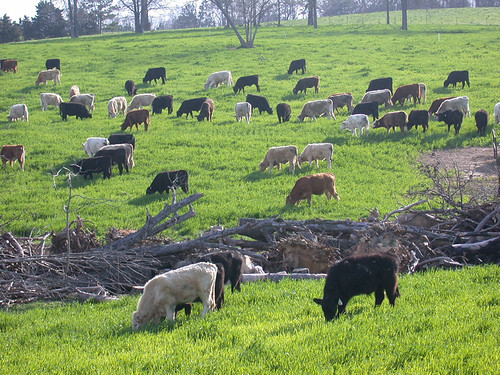Winter feeding program proving a success for cattle producers
By Ryan McGeeney
U of A System Division of Agriculture
Feb. 10, 2017
Fast Facts:
- Program designed to lower winter feeding costs for producers
- With about 23,000 beef cattle operations in Arkansas, savings could be in the tens of millions statewide, if adopted
(725 words)
VAN BUREN COUNTY, Ark. — For years, Shane Gadberry, an associate professor of ruminant nutrition and animal science for the University of Arkansas System Division of Agriculture, has been working to help cattle producers in central Arkansas get the most “bang for their buck” when it comes to feeding their herds through the winter, and ending up with healthy cows in the spring.
As the emerging data increasingly support the efficacy of their efforts, Gadberry, the Cooperative Extension Service agents of Van Buren County and researchers at the Division of Agriculture’s Southwest Research and Extension Center (SWREC) in Hope can point to a major potential impact on the state’s thousands of beef cattle operations.
The program engages county agents to recruit cattle producers in their respective counties to submit soil and hay samples to the SWREC for analysis. With the goal of keeping cows at the appropriate weight through the winter months — neither too thin nor too fleshy — the agents make recommendations on what kind, if any, nutritional supplementation producers should give to their cattle.
“With the hay test, what we find is that some producers realized they were supplementing when they didn’t need to be,” Gadberry said. “In other cases, we often find that producers are using the wrong type of supplement. So we shift the emphasis to the more appropriate type of supplement.
“In the more severe cases, they might be supplementing protein,” he said. “It doesn’t take much protein to overcome a protein deficiency. But when we look at their hay test, we find that the actual shortage is in energy. So they may spend the same amount of money, but on a more appropriate feed.”
Leon Wilson, a cattle producer who began managing a cow-calf operation near Dennard, Arkansas when he retired from education about 25 years ago, said he had participated in the winter feeding program multiple times over the past several years.
“The most important part of the program for me was the soil testing and the advice they gave me on purchasing fertilizer,” Wilson said. He said he had begun mixing in clover with his fescue on a Cooperative Extension Service agent’s advice through the program.
“My cows stay in pretty good shape, winter-wise, even though I don’t have barns sufficient for cattle inside,” Wilson said. They pretty well stay outside, and they stay in pretty good health.”
Based on survey data collected over the past two years, Gadberry said about two-thirds of participating producers report adopting agents’ recommendations completely, while the remaining third report adopting the recommendations at least partially. Fifty-one producers in eight north Arkansas counties participated in the program during the 2015-2016 winter.
Gadberry said growers who adopted his team’s recommendation in recent years saw a median savings of more than $22 per cow per year in feed expenditures, entering the spring with a healthier herd to boot. And in a state with tens of thousands of beef cattle operations, that could translate into a major economic impact.
“The direct impact to participating farms last winter was about $47,000,” Gadberry said. “Now, if we consider that there’s 23,000 beef cattle operations in Arkansas — not all of them are in this situation, but if you look at our hay tests that come through the diagnostic site at Fayetteville, we do know that about 60-70 percent of the time, the hay samples did not meet cow lactation requirements.”
Gadberry said that when cows drop below healthy calving weight, the calving cycle becomes increasingly delayed.
“It’s easy enough to measure savings in reduced feed costs,” Gadberry said. “But the big impact, that’s harder to measure, is on reproduction. We know that cows calving in moderate to thin condition are going to be less likely to breed back in a short time than cows that are calving in moderate to good condition.
“Reproduction is the most important factor that drives the income, the economy, of beef cattle operation. So if we short cattle on feed, it costs us in reduced reproductive rates. So our first investment is to make sure we’re managing those cows every year, to calves in good body condition, and minimizing body condition loss after calving,” he said.
To learn more about recommendation programs available to producers through the Division of Agriculture and the Cooperative Extension Service, contact your local Cooperative Extension Service Agent or visit www.uaex.uada.edu.
Pursuant to 7 CFR § 15.3, the University of Arkansas System Division of Agriculture offers all its Extension and Research programs and services (including employment) without regard to race, color, sex, national origin, religion, age, disability, marital or veteran status, genetic information, sexual preference, pregnancy or any other legally protected status, and is an equal opportunity institution.
# # #
Media Contact: Mary Hightower
Dir. of Communication Services
U of A Division of Agriculture
Cooperative Extension Service
(501) 671-2126
mhightower@uada.edu
Related Links
